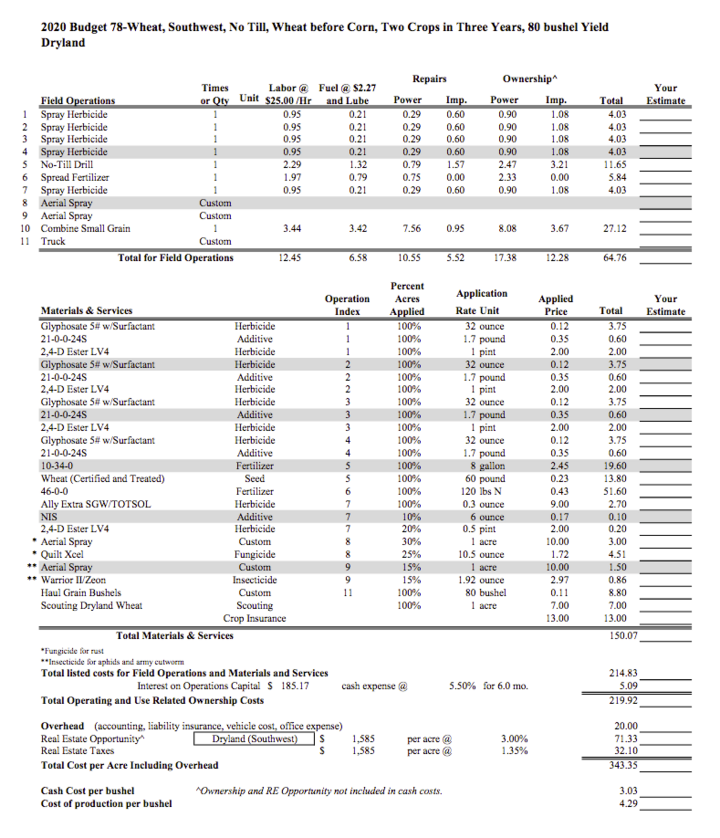Including winter wheat in the cropping system does not appear to be a profitable decision when one only examines the production costs and expected returns. Generally, there are additional production and economic benefits (35 to 100 bushels per acre increase in corn or grain sorghum yield) that should be considered. First, we will review the cost of production and then discuss other potential benefits of including winter wheat in the cropping system.
There are seven winter wheat crop budgets included amongst the 2020 Nebraska Crop Budgets. The cost of production ranges from $3.88 to $5.50 per bushel in the 2020 wheat budgets. Cash costs per bushel of production in these budgets range from $2.87 to $3.62. The Nebraska Farm Business Inc., 2019 Whole State Average Farm Financial Data report indicated direct production cost for wheat for the seven operations included in their analysis at $4.18 per bushel and total cost of $5.06 with allocated expenses added.
The University of Nebraska-Lincoln crop budgets and the cost of production in the Nebraska Farm Business Report for wheat do not credit the other potential benefits of including winter wheat in the cropping system. These benefits include, in areas with limited precipitation, the accumulation on average of three inches of soil water after winter wheat harvest which usually benefits the next year’s corn or sorghum crop with an increase in yield of approximately 35 bushels per acre.
Yes, we have experience where there was as much as 100 bushels or more difference in yield where corn or grain sorghum followed winter wheat in the cropping system as compared to following a summer crop. How did this occur? With the average annual 3 inches of additional soil water saved to the soil profile after wheat harvest in the fall plus the reduced soil evaporation from the wheat stubble mulch, under drought conditions the corn or grain sorghum that followed a good winter wheat crop did not suffer from the drought for approximately an additional 3 weeks. This compared to corn or grain sorghum that followed a summer crop who’s growth was terminated by the drought. The result was as much as 100 bushels or more in yield occurred when adequate rainfall occurred during the 3 week period followed by enough rainfall to sustain the crop needs. The corn or grain sorghum yield depended on the amount of additional rainfall.
Other benefits of wheat production include controlling or reducing pest problems, and winter wheat helps maintain soil organic matter. It is estimated that two to two and a half tons of crop residue per year is needed to maintain soil organic matter. Wheat generates 100 pounds of crop residue per bushel while corn and grain sorghum provide 50 pounds per bushel. Cover crops provide similar benefits; however, in areas with limited precipitation, one must consider the benefits of the cover crop against the soil water used.
Wheat prices were generally above corn prices before the introduction of distillers grain, a cereal by-product of the distillation process, which is great cattle feed. Due to the higher protein content in wheat as compared to corn, cattle feeders would include winter wheat to balance rations, especially when the wheat price got closer to the corn price.
After determining your cost of production including operating expenses, ownership costs, and cash and non-cash overhead, consider the soil improvement, water, and weed reduction, and potential feed benefits of wheat production on your operation. These benefits can provide a positive economic boost to your operation, not accounted for in typical enterprise budgeting.
Examining a Sample Winter Wheat Budget
Within the seven UNL winter wheat budgets, you may find a budget that comes closest to the winter wheat production system in your operation. The budgets are available to download in both PDF and Excel file formats.
For example, budget #78 (Figure 1) in the 2020 Nebraska Crop Budgets is a dryland, no-till before corn (also grain sorghum), two crops in three years, 80 bushel yield budget. The total cost of production per bushel is estimated at $4.29 while the cash cost per bushel is $3.03. This budget includes the cost of fallow in the spring and summer before winter wheat seeding in the fall.
Examine each item in the budget and add your cost if it is different from the cost shown in the budgets. You will notice on some items that the percent acres applied is less than 100%. For budget #78, noted are several pesticide applications that are applied on less than 100% of the acres. Twenty-five percent acres applied indicates that an operation is performed one in four years while fifteen percent is representative of a one in seven-year application.
If you have questions, please contact Glennis McClure (gmcclure3@unl.edu) or Robert Klein (robert.klein@unl.edu).


